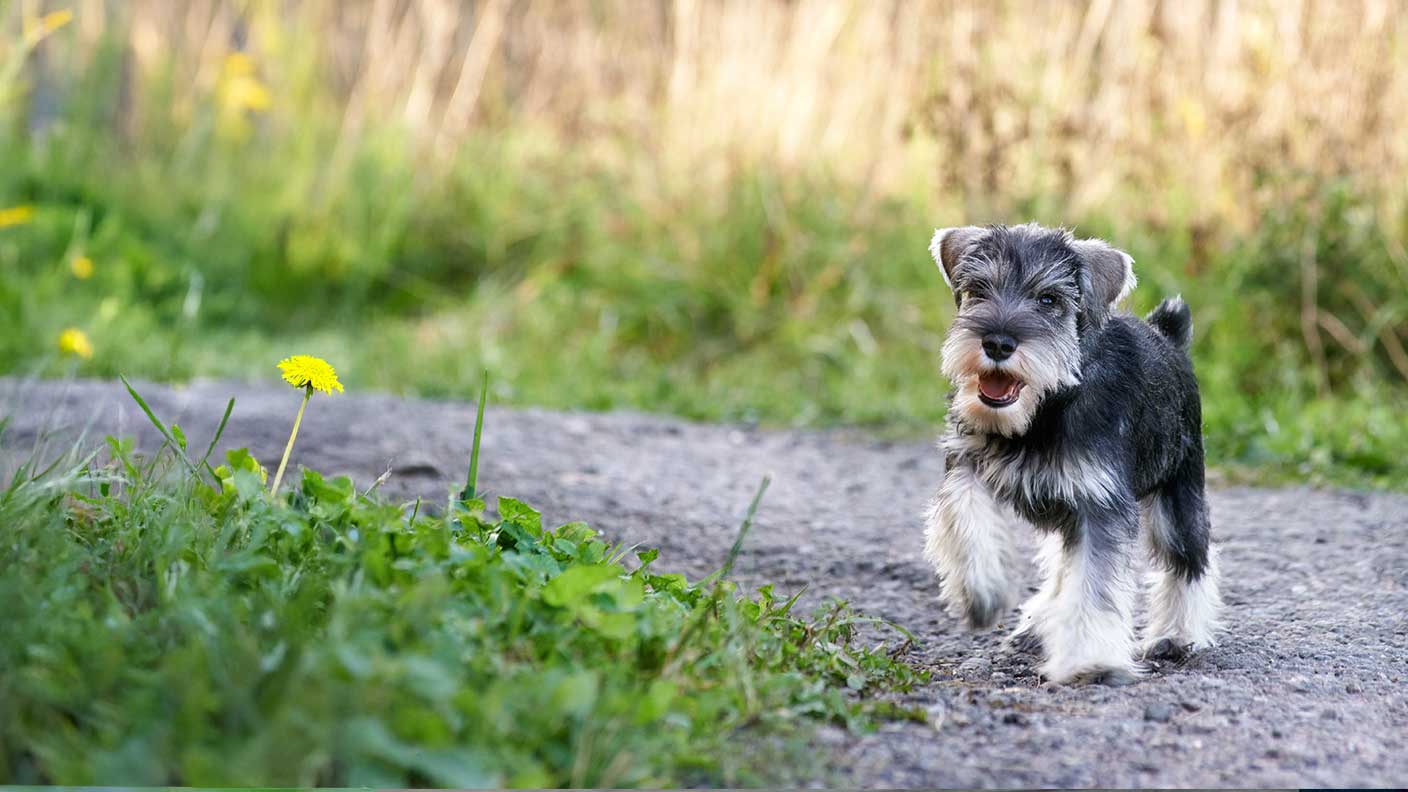Miniature Schnauzer dog breed information and advice
Originally bred as a working dog on German farms, the Miniature Schnauzer was a result of breeding a standard Schnauzer with smaller breeds including Miniature Poodles , Miniature Pinschers and Affenpinschers. Loved for their characteristic beard and stance, they’re one of the most popular dog breeds across the world.
Is a Miniature Schnauzer right for you? Read our guide to discover information about the mini-Schnauzer breed, including their temperament and personality. We’ll also share tips on how to care for a Miniature Schnauzer, including training, diet, exercise and grooming needs.
Miniature Schnauzer facts
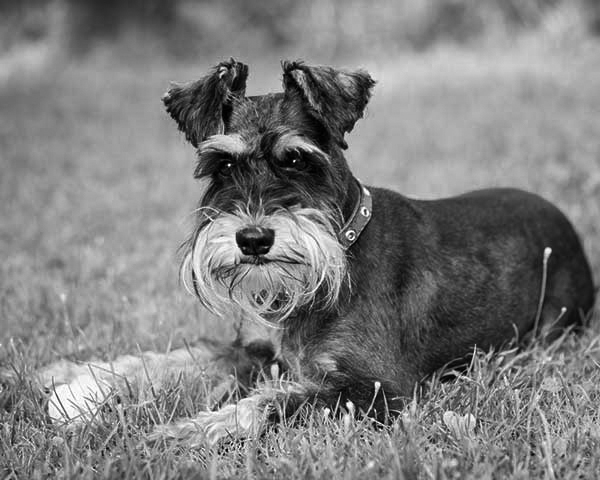
| Lifespan | 12 - 15 years |
| How much | £650 - £2,000 |
| Size | 33 - 35.6 cm |
| Weight | 6.4 - 10.1 kg |
| Colours | pepper and salt, pure black, black and silver, white |
| Grooming | once a week |
| Temperament | obedient, fearless, intelligent, friendly |
| Exercise | At least an hour a day |
Pet insurance for your Miniature Schnauzer
No one wants a poorly pet, but unfortunately, illnesses and injuries can happen to any dog at any age. Puppy insurance for your Miniature Schnauzer is important to make sure they’re covered from the get-go.
Regular health checks with your vet will help to spot problems from an early stage. And pet insurance can take away the concern of paying for treatment.
There are some common health conditions that Miniature Schnauzers are more predisposed to, including:
Sainsbury’s Bank Pet Insurance
With Sainsbury's Bank Pet Insurance we can insure your Miniature Schnauzer from as young as eight weeks of age. We have three different dog insurance policies:
- Lifetime – our most comprehensive cover which covers up to £10,000 of vet costs each year.
- Maximum benefit – cover for illnesses, accidents and conditions per condition – up to your policy limits.
- Time limited – covers vet fees for short-term health issues of up to £3,000, or for 12 months.
Puppy insurance for your Miniature Schnauzer can be started as young as eight weeks old and can be continued for their full lifespan.
Please note that we won't cover any pre-existing conditions and that terms, conditions, excesses, exclusions and limitations apply.
How to care for a Miniature Schnauzer
It goes without saying that you’ll need to take your Miniature Schnauzer to the vet regularly to check for any health issues. But you’ll also need to think about day-to-day care for your dog. Here are some tips to help you stick to a routine that will help your mini Schnauzer live a happy and healthy life.
Feeding and nutrition
As a puppy, you should feed a Miniature Schnauzer around 3-4 times a day and gradually move down to 1-2 times a day as they grow. A Miniature Schnauzer will reach full size by the time they are a year old.
An adult dog should weigh between 6.4 - 10.1 kg, depending on their size. To keep your pooch at a healthy weight you should weigh their food using the guidelines on the food packaging. If you’re concerned about your Miniature Schnauzer’s weight, speak to your vet for advice.
Exercise
Miniature Schnauzers need at least an hour of exercise every day to keep them happy and healthy.
They also need mental stimulation to keep their minds occupied. Varying their walks, allowing them time to sniff, training, agility and puzzle games will ensure your dog is content and well behaved.
Training
Temperament and behaviour
Despite being part of the Terrier group, Miniature Schnauzers are less noisy and feisty than other terriers. They have an extroverted, lively temperament and are good with children and newcomers. They are intelligent and eager to please which makes them quick to learn and easy to train.
However, mini-Schnauzers can be quite vocal, and prone to barking at ‘intruders’ like the postman. They also prefer the company of their family, and don’t like to be left alone for long periods. Their high prey drive means Miniature Schnauzers don’t mix well with smaller pets like cats or rabbits, and they should be kept under close supervision while off lead in public parks.
Common health problems
The Miniature Schnauzer is generally a healthy breed but there are a few health issues that you need to be aware of. Regular vet health checks will help to spot signs of these conditions and provide treatment where possible. Having Miniature Schnauzer pet insurance in place will cover the costs of any treatment your pooch needs to keep them happy and healthy.
Cataracts
Miniature Schnauzer can experience cataracts, which affects vision and can result in blindness. The lens of the eye is normally clear, but with cataracts it becomes opaque or white. This blocks light from entering the eye, meaning the dog’s vision is reduced. The development of cataracts can be hereditary or caused by diabetes, inflammation of the eye, or glaucoma. Luckily, cataracts can be treated by getting surgically removed.
Progressive retinal atrophy (PRA)
PRA is a group of inherited eye diseases, which slowly leads to blindness. This can take months or years and is sadly not preventable. The condition usually affects dogs aged 3-8 years, but with Miniature Schnauzers signs may develop earlier. There’s no cure but blind dogs can still live happily for their full life expectancy.
Hyperlipidaemia
Hyperlipidaemia describes an abnormal amount of fat or fatty substances in the blood. Signs of this condition include vomiting, diarrhoea, seizures and abdominal pain. Most hyperlipidaemias in dogs are caused by another disease or by their diet. Sufferers have an increased chance of developing other conditions such as pancreatitis, diabetes or acute kidney injury (AKI). Drugs and changes to the dog’s diet can help treat the condition.
So, is a Miniature Schnauzer right for you?
Their friendly, lively and obedient personality is suited to most families. You can rest easy knowing a Miniature Schnauzer will be your devoted companion for their entire life. You’ll have no problems with training and their exercise demands are minimal. They’re great with children, so you don’t need to worry about introducing them to your family.
Frequently asked questions
How long do Miniature Schnauzers live for?
A Miniature Schnauzers life expectancy is 12-15 years. Diet, exercise, grooming and training all play a part in your dog’s health and can affect their lifespan. For example, an overweight dog is more likely to suffer from health problems.
What dog group is a Miniature Schnauzer?
This dog breed is part of the Terrier group because it was bred to hunt and kill vermin and guard their families’ home. Miniature Schnauzers have a similar temperament to other dog breeds in the Terrier group. They are obedient, energetic, fearless and spirited.
What is a Miniature Schnauzer?
Miniature Schnauzers were originally bred in Germany to be a ratting dog on farms. They were also used as guard dogs. The Standard Schnauzer was crossbred with smaller breeds, such as Affenpinscher and Poodle, to create this miniature breed. Its small stature meant it was ideal for fitting in smaller spaces where vermin nest.
Can Miniature Schnauzers be left alone?
Miniature Schnauzers prefer the company of their families, but they can be left alone for several hours with the right training. If you plan to leave your dog alone, gradual training to help them get used to being alone is key. Give your dog mental and physical stimulation before you leave them so they can relax at home while you’re gone. Dogs who haven’t learned to be content by themselves may be destructive or exhibit separation anxiety.
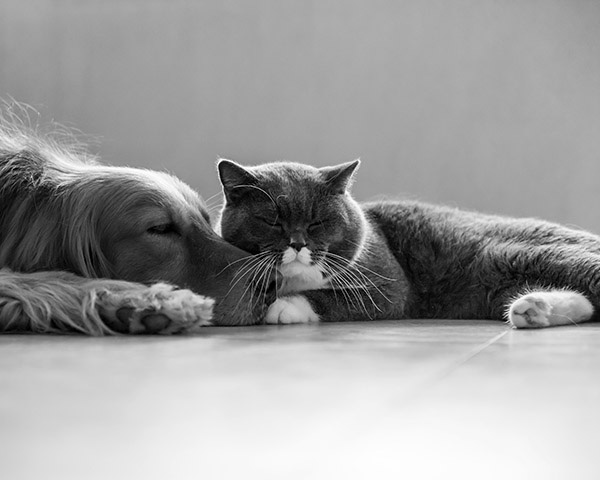
Browse our guides
Choose from our list of helpful guides and information
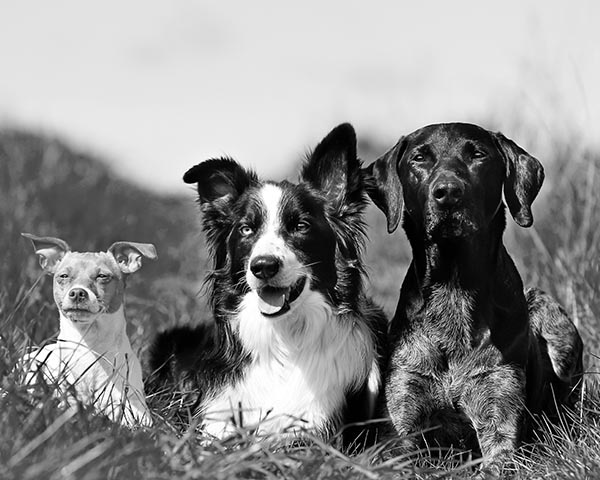
Explore dog breeds
Find out how to keep your dog healthy and happy
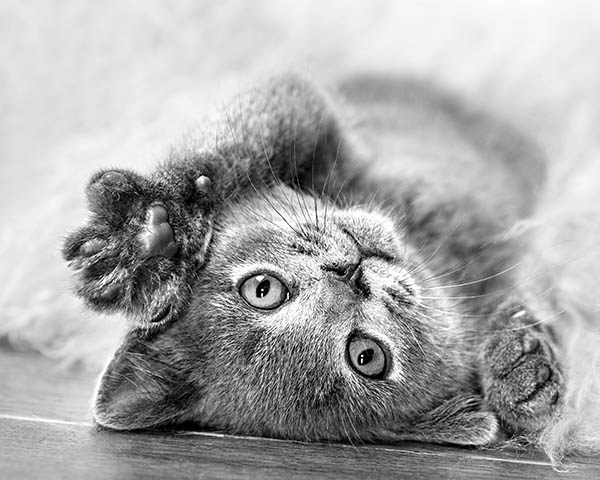
Cat breed guides
How to care for your cat, common health problems and more
References
Content provided from Vetstream's Vetlexicon Canis - www.vetstream.com/treat/canis 
Vetstream ltd (online) Schnauzer: miniature. In: Vetlexicon Canis. Vetstream Ltd, UK. Website: https://www.vetstream.com/treat/canis/breeds-pages/schnauzer-miniature. 
Brooks D E & Williams D L (online) Lens: hereditary primary cataract. In: Vetlexicon Canis. Vetstream Ltd, UK. Website: https://www.vetstream.com/clinical-reference/canis/diseases/lens-hereditary-primary-cataract. 
Gerding P (online) Cataract. In: Vetlexicon Canis. Vetstream Ltd, UK. Website: https://www.vetstream.com/clinical-reference/canis/diseases/cataract. 
Vetstream Ltd (online) Cataract Owner Factsheet. In: Vetlexicon Canis. Vetstream Ltd, UK. Website: https://www.vetstream.com/clinical-reference/canis/owner-factsheets/cataract. 
Brooks E, William D L & Gould D (online) Retina: generalized progressive retinal atrophy. In: Vetlexicon Canis. Vetstream Ltd, UK. Website: https://www.vetstream.com/clinical-reference/canis/diseases/retina-generalized-progressive-retinal-atrophy. 
Vetstream Ltd (online) Progressive retinal atrophy (PRA) Owner Factsheet. In: Vetlexicon Canis. Vetstream Ltd, UK. Website: https://www.vetstream.com/clinical-reference/canis/owner-factsheets/progessive-retinal-atrophy-(pra). 
Bazelle J & Braund K (online) Hyperlipidemia. In: Vetlexicon Canis. Vetstream Ltd, UK. Website: https://www.vetstream.com/clinical-reference/canis/diseases/hyperlipidemia. 
Terms and conditions
Important information
Sainsbury's Bank plc, Registered Office, 33 Charterhouse Street, London, EC1M 6HA (registered in England and Wales, no 3279730) is authorised by the Prudential Regulation Authority and regulated by the Financial Conduct Authority and the Prudential Regulation Authority (register no. 184514).
Sainsbury's Supermarkets Ltd is an appointed representative of Sainsbury's Bank plc. Sainsbury's Bank plc acts as an introducer to Pinnacle Insurance Ltd who is authorised by the Prudential Regulation Authority and regulated by the Financial Conduct Authority and the Prudential Regulation Authority (register number 110866). Registered office: 4th Floor, Limelight, Elstree Way, Borehamwood, Hertfordshire, WD6 1JH. Sainsbury’s Bank Pet Insurance is arranged, administered and underwritten by Pinnacle Insurance Ltd. Sainsbury's Bank plc and Pinnacle Insurance Ltd are not part of the same corporate group.
We do not provide personal recommendations to customers.
